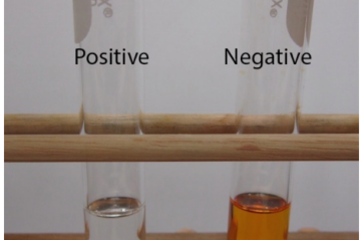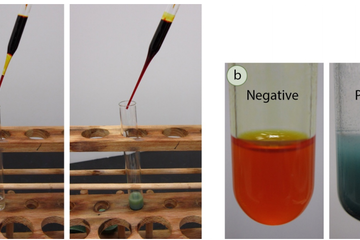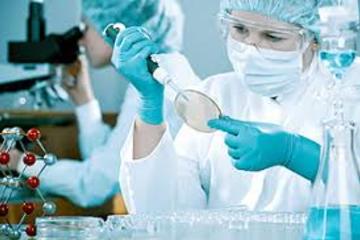Browse
Posted on: #iteachmsu

ASSESSING LEARNING
Chemical testing overview
Overview
Before spectroscopic analysis (IR, NMR) became commonplace in the organic chemistry lab, chemical tests were heavily relied upon to support compound identification. A chemical test is typically a fast reaction performed in a test tube that gives a dramatic visual clue (a color change, precipitate, or gas formation) as evidence for a chemical reaction. For example, addition of an orange chromic acid reagent to some compounds causes the chromium reagent to change to a blue-green color (Figure 6.37a). This is considered a "positive" test result, and in this case indicates the presence of a functional group that can be oxidized (alcohol or aldehyde). A negative test result is retention of the original color of the reagent, in this case the orange color
Before spectroscopic analysis (IR, NMR) became commonplace in the organic chemistry lab, chemical tests were heavily relied upon to support compound identification. A chemical test is typically a fast reaction performed in a test tube that gives a dramatic visual clue (a color change, precipitate, or gas formation) as evidence for a chemical reaction. For example, addition of an orange chromic acid reagent to some compounds causes the chromium reagent to change to a blue-green color (Figure 6.37a). This is considered a "positive" test result, and in this case indicates the presence of a functional group that can be oxidized (alcohol or aldehyde). A negative test result is retention of the original color of the reagent, in this case the orange color
Authored by:
Chathuri

Posted on: #iteachmsu


Chemical testing overview
Overview
Before spectroscopic analysis (IR, NMR) becam...
Before spectroscopic analysis (IR, NMR) becam...
Authored by:
ASSESSING LEARNING
Monday, Aug 26, 2019
Posted on: #iteachmsu

ASSESSING LEARNING
Chemical testing overview
Overview
Before spectroscopic analysis (IR, NMR) became commonplace in the organic chemistry lab, chemical tests were heavily relied upon to support compound identification. A chemical test is typically a fast reaction performed in a test tube that gives a dramatic visual clue (a color change, precipitate, or gas formation) as evidence for a chemical reaction. For example, addition of an orange chromic acid reagent to some compounds causes the chromium reagent to change to a blue-green color (Figure 6.37a). This is considered a "positive" test result, and in this case indicates the presence of a functional group that can be oxidized (alcohol or aldehyde). A negative test result is retention of the original color of the reagent, in this case the orange color
Before spectroscopic analysis (IR, NMR) became commonplace in the organic chemistry lab, chemical tests were heavily relied upon to support compound identification. A chemical test is typically a fast reaction performed in a test tube that gives a dramatic visual clue (a color change, precipitate, or gas formation) as evidence for a chemical reaction. For example, addition of an orange chromic acid reagent to some compounds causes the chromium reagent to change to a blue-green color (Figure 6.37a). This is considered a "positive" test result, and in this case indicates the presence of a functional group that can be oxidized (alcohol or aldehyde). A negative test result is retention of the original color of the reagent, in this case the orange color
Authored by:
Chathuri

Posted on: #iteachmsu


Chemical testing overview
Overview
Before spectroscopic analysis (IR, NMR) becam...
Before spectroscopic analysis (IR, NMR) becam...
Authored by:
ASSESSING LEARNING
Monday, Aug 26, 2019
Posted on: #iteachmsu

ASSESSING LEARNING
Chemical testing overview
Before spectroscopic analysis (IR, NMR) became commonplace in the organic chemistry lab, chemical tests were heavily relied upon to support compound identification. A chemical test is typically a fast reaction performed in a test tube that gives a dramatic visual clue (a color change, precipitate, or gas formation) as evidence for a chemical reaction. For example, addition of an orange chromic acid reagent to some compounds causes the chromium reagent to change to a blue-green color (Figure 6.37a). This is considered a "positive" test result, and in this case indicates the presence of a functional group that can be oxidized (alcohol or aldehyde). A negative test result is retention of the original color of the reagent, in this case the orange color
Authored by:
Chathuri

Posted on: #iteachmsu


Chemical testing overview
Before spectroscopic analysis (IR, NMR) became commonplace in the o...
Authored by:
ASSESSING LEARNING
Monday, Aug 26, 2019
Posted on: #iteachmsu

NAVIGATING CONTEXT

Posted on: #iteachmsu


BioEngineering # biological testings
Testing article
Authored by:
NAVIGATING CONTEXT
Tuesday, Aug 13, 2019
Posted on: #iteachmsu

Getting Started with #iteachmsu Digital Commons: A Consideration of Accessibility
The world has moved to an experience driven economy. Are you there yet?
Irrespective of the industry you belong to, customer centricity will be the number one competitive advantage for sustained growth in the new economy. Customers are evolving, workforce is changing and value chains of yesteryears are getting deconstructed - ITC Infotech’s Digitaligence@Work will help you innovate, by going beyond creating a list of ‘digital priorities’ to creating priorities for digitization.
WHAT IS DIGITALIGENCE?
ITC Infotech’s Digitaligence@Work infuses technology with domain, data, design, and differentiated delivery to significantly enhance experience and efficiency, enabling our clients differentiate and disrupt the business.
Irrespective of the industry you belong to, customer centricity will be the number one competitive advantage for sustained growth in the new economy. Customers are evolving, workforce is changing and value chains of yesteryears are getting deconstructed - ITC Infotech’s Digitaligence@Work will help you innovate, by going beyond creating a list of ‘digital priorities’ to creating priorities for digitization.
WHAT IS DIGITALIGENCE?
ITC Infotech’s Digitaligence@Work infuses technology with domain, data, design, and differentiated delivery to significantly enhance experience and efficiency, enabling our clients differentiate and disrupt the business.
Authored by:
Chathuri

Posted on: #iteachmsu

ASSESSING LEARNING
Nature - weather conditions
Testing -
Article - Weather conditions country profile
Article - Weather conditions country profile
Authored by:
Chathuri

Posted on: #iteachmsu


Nature - weather conditions
Testing -
Article - Weather conditions country profile
Article - Weather conditions country profile
Authored by:
ASSESSING LEARNING
Monday, Aug 12, 2019
Posted on: #iteachmsu

ASSESSING LEARNING
Biology - Testing 2
Testing continue part1
biological testing services. Biological Service. With an extensive versatile technical platform, coupled to over 500 m2 of independent laboratory space equipped ...
biological testing services. Biological Service. With an extensive versatile technical platform, coupled to over 500 m2 of independent laboratory space equipped ...
Authored by:
Chathuri

Posted on: #iteachmsu


Biology - Testing 2
Testing continue part1
biological testing services. Biol...
biological testing services. Biol...
Authored by:
ASSESSING LEARNING
Monday, Aug 12, 2019
Posted on: #iteachmsu

ASSESSING LEARNING
Biology - Testing
BIOLOGICAL TESTING
We analyse chemicals and substances used in the workplace to determine if occupational health and safety exposure levels have been exceeded.
Our laboratory utilises state of the art modern instrumental techniques. The dangerous chemicals we test for can include:
industrial chemicals
solvents & BTEX
cytotoxic drugs
arsenic speciation
herbicides and insecticides
heavy metals like lead, mercury and cadmium
Our state of the art techniques include:
GC-MS
LC-MS/MS
LC-ICPMS
XRD
XRF
FTIR
PLM microscopy
Gravimetrics
Laboratory staff are specialists in the above areas with extensive experience.The laboratory is NATA accredited and complies with the requirements of ISO/IEC 17025. Our NATA accreditation number is 3726.
We analyse chemicals and substances used in the workplace to determine if occupational health and safety exposure levels have been exceeded.
Our laboratory utilises state of the art modern instrumental techniques. The dangerous chemicals we test for can include:
industrial chemicals
solvents & BTEX
cytotoxic drugs
arsenic speciation
herbicides and insecticides
heavy metals like lead, mercury and cadmium
Our state of the art techniques include:
GC-MS
LC-MS/MS
LC-ICPMS
XRD
XRF
FTIR
PLM microscopy
Gravimetrics
Laboratory staff are specialists in the above areas with extensive experience.The laboratory is NATA accredited and complies with the requirements of ISO/IEC 17025. Our NATA accreditation number is 3726.
Authored by:
Chathuri
Posted on: #iteachmsu

Biology - Testing
BIOLOGICAL TESTING
We analyse chemicals and substances used in the...
We analyse chemicals and substances used in the...
Authored by:
ASSESSING LEARNING
Monday, Aug 12, 2019

